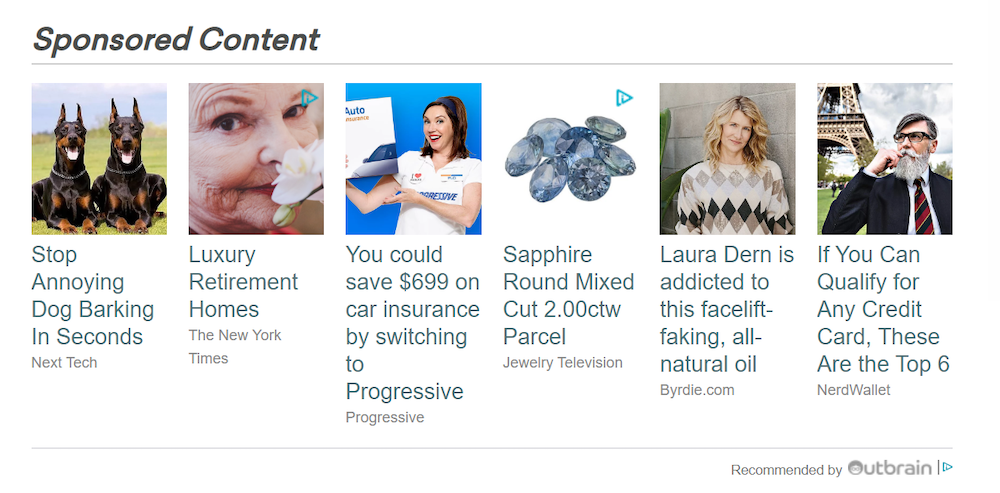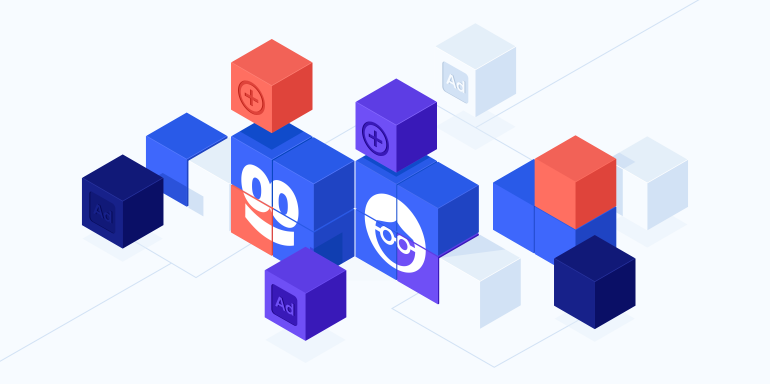In what’s being called an attempt to compete with the digital ad duopoly, Taboola and Outbrain have merged to create a single company. The name of this entity will remain Taboola, but its size and scope could allow it to square off with some of the biggest names in digital advertising.
The Taboola-Outbrain merger
Taboola and Outbrain, two digital advertising companies known for providing recommended content at the bottom of publisher articles, have combined to form a single entity. If there was speculation as to why, the reason can be found in the title of a press release from Taboola:

By now, the entire digital ad industry is aware that most of its ad dollars funnel through a duopoly: Facebook and Google. Along with Amazon, these ad giants hog 70% of digital ad spend. According to Adam Singolda, Founder & CEO of Taboola, this merger gives advertisers somewhere else to look when it comes to budgetary allocation:
Over the past decade, I’ve admired Outbrain and the innovation that Yaron Galai, Ori Lahav, and the rest of the Outbrain team have brought to the marketplace. By joining forces, we’ll be able to create a more robust competitor to Facebook and Google, giving advertisers a more meaningful choice.
He continues:
We’re passionate about driving growth for our customers and supporting the open web, which we consider critical in a world where walled gardens are strong, and perhaps too strong. Working together, we will continue investing to better connect advertising dollars with local and national news organizations, strengthening journalism over the next decade. This is why we’re merging; this is our mission.
This “meaningful choice” will reflect offerings and branding that remain to be seen. What we do know, though, is that the new Taboola will have far greater scope. Operating across 50 countries in 23 offices, the company says it will reach 2.6 billion people monthly through its 20,000 partners, which include brands like CNBC, NBC News, USA TODAY, Sankei, Huffington Post, Microsoft, Business Insider, and The Independent.
Singolda will assume the CEO position of the combined company, which is reportedly valued at $2 billion, making the deal worth $850 million. Under the terms of the merger agreement, Outbrain shareholders will receive shares representing 30% of the combined company plus $250 million in cash.
Current management and board members from both companies will make up the new Tabola’s board. Eldad Maniv, President & COO of Taboola and David Kostman, co-CEO of Outbrain, will work closely together on managing all aspects of the post-merger integration. Yaron Galai will remain committed to the success of the combined company, and actively assist with the transition for the 12 months following the closing.
Taboola and Outbrain: Background
Historically, Taboola and Outbrain have been rivals in a game to help advertisers earn traffic, and publishers maximize revenue from each visitor. Even those who don’t know them by name will recognize their product — ad placements at the bottom of an article to get visitors clicking to related content:

Known colloquially as “chumboxes,” these modules rose to popularity when banner blindness began to take widespread effect. As internet users stopped clicking banner ads, the revenue to publishers plummeted. Chumboxes were a way to recuperate some of the losses. With just a few lines of code, a publisher could make money by natively showcasing ads for related content.
Outbrain and Taboola have always been leaders in this niche. The new Taboola, however, sets its sights beyond the niche to higher goals, with a merger that’s been ten years in the making.
Since their founding in 2006, both Outbrain and Taboola have shared many similarities. Aside from their founding year, both are headquartered in New York and have development centers in Israel. Both provide a similar set of products, and both have raised major funding (Taboola: $160 million, and Outbrain: $194 million) and gone on to win some of the web’s most prominent names as clients. It’s these similarities that made them fierce rivals, and eventually partners.
Their differences, though, is what Ingrid Lunden calls their biggest asset going forward:
Although there is a lot that is similar between Taboola and Outbrain, there are differences that will potentially create a company that will continue expanding into other areas.
For example, Outbrain acquired a company in 2017 called Zemanta that has given it a foothold in programmatic advertising, while Taboola has made moves to expand into video inventory to better compete with the force of YouTube in video advertising.
It’s these differences, along with their combined strengths, that Singolda hopes will allow the new Taboola to compete with the likes of Facebook and Google — something he sees as a necessary next step in a “vulnerable world.”
I just spoke on Squawk Box in July, and this morning, about how I feel the world is vulnerable in the wake of Facebook and Google becoming strong, and perhaps too strong. Advertisers want choice, more transparency, less dependency. Users are thinking about privacy, not only lawyers. And Publishers want to grow loyal relationships with users, and capitalize on that growth, finding ways to generate exciting revenue.
The world needs help, it’s hurting, and we depend on less than five companies to keep the lights on for a big ecosystem out there. I think the challenge when you’re a strong consumer company, owning direct relationships with users, is that if given a choice to choose between yourself to a world of partners out there (publishers, carriers, OEMs, businesses, etc.) – you might just choose you.
But with speculation surrounding what exactly the new Taboola will offer its users, it’s hard to know how the company plans to accomplish such lofty goals of curing an industry and making the world less vulnerable to the Google/Facebook duopoly.
The strategic benefits of the Taboola-Outbrain merger
While the specifics are to be determined, Singolda says their customers can expect some valuable benefits.
If you’re an advertiser, we’ll have more reach for you, we will help you drive more growth, and we’ll innovate faster and better to provide new features for you to try. Commerce, app-installs, more video, and more.
If you’re a publisher/OEM/Carrier, you’ll generate more revenue as we attract more and more advertisers to our marketplace, and spend more time and energy on our AI. It’s the dynamics of all healthy marketplaces. More demand drives better yields. We’ll innovate more on our platform as a whole -- more editorial platforms, more analytics and insights, more audience acquisition capabilities, and more.
The promises of “more and more and more” are complemented by a slightly longer and more detailed list of “key strategic benefits” from the official press release:
- Increased Advertiser Choice: The combined company will be able to provide advertisers, from small businesses to global brands, with a meaningful competitive alternative to Google and Facebook.
- Greater Advertising Efficiency: A unified and consolidated buying platform will provide advertisers with greater efficiencies, helping them reach their awareness, consideration and conversion goals.
- Higher Revenue & User Engagement to Publishers, Mobile Carriers & Mobile OEMs: Through increased investment in technology and expanded reach, the combined platform will be able to increase revenue to publishers, mobile carriers and device manufacturers, and drive better user engagement.
- Accelerated Innovation: By combining two of the strongest data science and AI teams in the industry, and by accelerating investment in R&D, the company can better address the evolving needs of its partners and customers.
- Better Consumer Experience: Increasingly, Taboola’s and Outbrain’s solutions are embraced directly by consumers to help them discover what’s interesting and new, at moments when they’re ready to explore. For example, Taboola News is now embedded in over 60 million Android devices worldwide. The combined company will be able to accelerate the development of such innovative solutions, improving people’s ability to enjoy quality journalism.
Singolda believes that if the merger goes well, and the company can bring in more advertisers to the marketplace, the new Taboola can double, even triple revenue for their publishers.
Some, though, are not convinced.
Will the new Taboola be worth a try?
While some are passionate about what the merger can achieve, others on the outside are just as passionate in the opposite way. In an article for The Next Web, titled “Taboola and Outbrain, the two worst companies in the world, are merging,” Matthew Hughes calls Taboola and Outbrain “fundamentally evil.” Elaborating, he says:
They’re making us dumber and meaner. Both startups make money from spoon-feeding millions a diet of clickbait and dross. And far too much of the content they “recommend” is at the expense of other people.
He cites one example of a writer, Matt Logelin, whose wife died tragically in circumstances that apparently made for profitable clickbait. His story circulated the web in Taboola’s network, forcing Logelin to relive the tragedy in the form of an advertisement accompanied by clickbait headlines that he claims are false.
If the new Taboola claims to champion strengthening journalism, it’s clear that Hughes is among those who aren’t buying it. And he’s not the only one who has doubts about the new Taboola.
Digiday spoke to sources at five different publishers that currently use Taboola or Outbrain to find out what the merger could mean for their business. More than half said it had the potential to make the recommendation modules more valuable.
However, when you consider these were sources already using one of the platforms, and the tally was “more than half,” it doesn’t inspire much confidence.
Others are worried the merger could make revenue guarantees obsolete. Now that Outbrain and Taboola no longer compete for business, the guarantee checks once used to sway publishers will likely be affected.
Additionally, there’s still concern about quality control from some publishers, who fear the content in Taboola’s modules could potentially degrade user trust. Max Willens writes:
...the unsightliness of the widgets’ content made them a lightning rod that often divided publishers’ revenue and product teams. Though publishers have some flexibility in what kinds of ads they allow into the widgets, the lack of quality control at some publishers made the recommendation widgets synonymous with a certain kind of low-rent internet ugliness
This concern has prompted competitors of Taboola and Outbrain to step forward. According to Digiday, Revcontent, a smaller content recommendation engine that reaches around 400 million unique users per month, has grown by cutting its network 60%, offering more premium inventory, and giving advertisers more control over where their content is published. Together, these steps have raised CPMs for its publisher partners by nearly 120%, according to the company’s COO.
To stay on top, sources who spoke to Digiday believe the new Taboola will need to take similar action to earn the trust of other top publishers. Otherwise, they’ll suffer from the perception that all content recommendation engines are no more than breeding grounds for clickbait.
There are huge strides needed to eliminate this problem, or the unit just gets avoided altogether. There’s also a reputational issue -- for example, when speaking with a client about these widgets, their own personal experiences with it draws a negative connotation, and that impacts whether or not they would consider it for a campaign.
Get more from your ad spend
While the Taboola-Outbrain merger has marketing professionals divided on its value, one thing’s for sure: Their content recommendation product is worth serious consideration. And that’s especially true if the company succeeds in implementing its planned updates, and attracting new users, too.
But to maximize ad spend, you don’t have to wait for the new Taboola to reach maturity. You can start today with the Advertising Conversion Cloud™ from Instapage. Find out how with a personalized demo.

See the Instapage Enterprise Plan in Action.
Demo includes AdMap™, Personalization, AMP,
Global Blocks, heatmaps & more.
